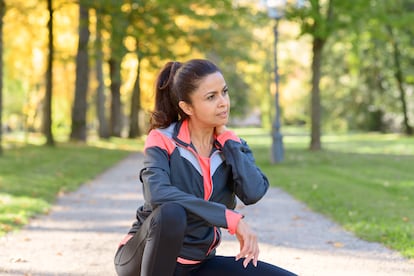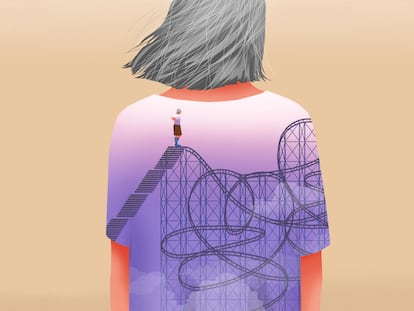Exercising ‘with the heat on’: Hot flashes and physical activity during menopause
Over 80% of women experience hot flashes as they go through menopause. Exercise can improve thermoregulatory control of sweating, skin and blood flow to the brain

“You hang in there.” That’s how Raquel, 54, left her doctor’s office. “It was absolute incomprehension. He told me that I just have to get through this [referring to menopause] and that’s it,” she told me.
No two women are the same, and no two menopauses are alike. Symptoms before, during and after the onset of menopause can have a major impact on women’s daily lives, including their social and sexual relationships, social life, family life and work. According to the Journal of Midlife Health, over 80% of women experience hot flashes. Approximately 55% of women have them as they enter the transition phase toward menopause (the definitive cessation of menstruation), the symptoms of which may begin with irregular periods. Hot flashes, a common symptom of the climacteric period, are uncomfortable and can last for many years. When they occur at night, they are known as night sweats. “I go to bed dressed in December and wake up as if it were August, with the sheets dripping in the middle of winter,” says Raquel.
Causes
Hot flashes can occur due to a reduction in the production of estrogens, causing thermoregulatory and vascular dysfunctions. In her book Con hormonas y a lo loco [Hormonal Like Crazy], Dr. Clotilde Vázquez explains it this way: “[Hot flashes] usually begin as a sudden sensation of heat in the upper part of the chest and face, often accompanied by reddening. Then, that sensation spreads throughout the body and lasts for between two and four minutes. Some women sweat during a hot flash and then have shivering and trembling when it passes. In addition, others may experience anxiety or palpitations during the process.”
These hot flashes can occur once or twice a day and wake a person up at night. “Many women ask me why hot flashes occur and how long they last. I tell them that they are vasomotor phenomena; in reality, the process involves both the dilation of blood vessels and the alteration of neurotransmitters,” Dr. Clotilde Vázquez says.
Exercising with a fan
“When I exercise it’s as if I had the heat on. I get really hot, [the heat] goes up my body, I take out the fan and apologize,” Raquel admits. We should stop apologizing for something that is completely natural. Take out the fan whenever and wherever you need to, without guilt, without stigma, without explanation..
In this regard, exercise may improve thermoregulatory control of sweating, skin and cerebral blood flow. One study examined the possible effects of strength training on vasomotor symptoms in postmenopausal women. The training routine was done three times per week and included eight exercises performed with 8-12 repetitions divided into two sets. The loads were established individually, based on tests. The results: the program decreased the frequency of moderate and severe hot flashes.
Raising the temperature
Hot flashes are sometimes quite unbearable. “I don’t get it... Who wants to raise their body temperature when they feel like they’re burning up inside?” Raquel asked me before she started exercising. Science finds that the more you move, the better your chances of curbing the intensity of hot flashes.
A sedentary lifestyle can worsen symptoms like fatigue, insomnia, depression, and weight gain. According to the JAMA Archives of Internal Medicine, improving body composition helps alleviate hot flashes. Another study showed that women whose routine includes regular, moderate exercise are better able to regulate their body temperature.
In fact, published studies found that people experiencing menopausal symptoms who participated in a program with activities that included jogging and cycling four to five times a week improved their ability to regulate body heat. In addition, during a hot flash, they exhaled less and showed less increase in skin temperature as compared to the non-exercising control group. Best of all, at the end of the study, the active participants had experienced a 60% reduction in the frequency of their hot flashes.
Cardiovascular risk
Many winter nights can turn into early summer mornings. It happens. Estrogen depletion can also increase the risk of cardiovascular disease. The Menopause journal has published a review addressing this issue and its relationship to hot flashes. A regular moderate-intensity training program that includes aerobic and strength exercises may be effective in reducing cardiovascular risk as well. Research says that fitness professionals who approach training from a gender perspective should advise women around the onset of menopause to exercise. Remember: the best exercise is the one you do well; to stick with it, you must find the one that works for you. Professionals are there to help.
Vasomotor symptoms can impact cutaneous vasodilation, sweating and cerebral blood flow. Research says that improvements in fitness come after approximately 16 weeks of training and reduce their severity.
According to research, strength training may help relieve hot flashes and maintain and build lean muscle mass. It also reduces the risk of osteoporosis, a silent disease characterized by decreased bone mass, which can lead to bone dependency and fractures.
Getting older is an achievement. Depending on how you approach aging, it could mean an increase in your freedom, an opportunity to modify aspects of your lifestyle, devote more time to yourself and take care of yourself as a form of self-love. Exercise can be a first step.
From theory to the practice
- According to the North American Menopause Society, when you have a hot flash, the hypothalamus—the part of the brain that regulates body temperature—mistakenly detects that you are warmer than you really are.
- Being sedentary increases the risk of heart disease, high blood pressure and other chronic health problems that become more common as we get older.
- Try to manage hot flashes by working out. Lower the intensity of your exercise. For example, if you’re running too fast, slow down; you can walk a little slower or reduce the weight of dumbbells if you experience symptoms.
- Breathe. Learn to do it mindfully and diaphragmatically. Research in the Menopause journal found that those who practiced slow breathing twice a day for 15 minutes had fewer hot flashes.
- Don’t forget to hydrate. Drink when you are thirsty, avoid fatigue, cramps and dizziness.
- Use nice but breathable clothes. A fan can be a good complement to your training.
- Keep the room where you exercise well ventilated.
- What do the guidelines say? According to the World Health Organization (WHO), you should do moderate aerobic physical activities for at least 150 to 300 minutes; or intense aerobic physical activities for at least 75 to 150 minutes; or an equivalent combination of moderate and intense activities throughout the week; You should also do strength training for two or more days a week, with exercises that work the major muscle groups. If you see these numbers as unattainable, start with daily living activities (walks, stairs, walk instead of taking the bus). Find an exercise you enjoy and don’t give up. As the WHO says: every movement counts.
- Start slowly; it’s never too late. There is an exercise for everyone, at every stage of life. Middle age is an opportunity.
- Nothing is quick or miraculous, and that is true of exercise as well. Studies show that changes come after about 16 weeks of training and reduce the severity of physiological symptoms.
Sign up for our weekly newsletter to get more English-language news coverage from EL PAÍS USA Edition
Tu suscripción se está usando en otro dispositivo
¿Quieres añadir otro usuario a tu suscripción?
Si continúas leyendo en este dispositivo, no se podrá leer en el otro.
FlechaTu suscripción se está usando en otro dispositivo y solo puedes acceder a EL PAÍS desde un dispositivo a la vez.
Si quieres compartir tu cuenta, cambia tu suscripción a la modalidad Premium, así podrás añadir otro usuario. Cada uno accederá con su propia cuenta de email, lo que os permitirá personalizar vuestra experiencia en EL PAÍS.
¿Tienes una suscripción de empresa? Accede aquí para contratar más cuentas.
En el caso de no saber quién está usando tu cuenta, te recomendamos cambiar tu contraseña aquí.
Si decides continuar compartiendo tu cuenta, este mensaje se mostrará en tu dispositivo y en el de la otra persona que está usando tu cuenta de forma indefinida, afectando a tu experiencia de lectura. Puedes consultar aquí los términos y condiciones de la suscripción digital.
More information
Archived In
Últimas noticias
Most viewed
- Reinhard Genzel, Nobel laureate in physics: ‘One-minute videos will never give you the truth’
- Oona Chaplin: ‘I told James Cameron that I was living in a treehouse and starting a permaculture project with a friend’
- Pablo Escobar’s hippos: A serious environmental problem, 40 years on
- Charles Dubouloz, mountaineering star, retires at 36 with a farewell tour inspired by Walter Bonatti
- Why we lost the habit of sleeping in two segments and how that changed our sense of time











































